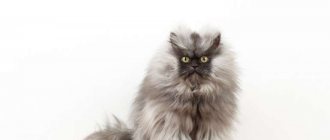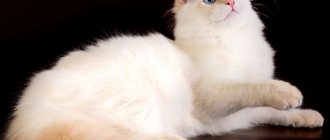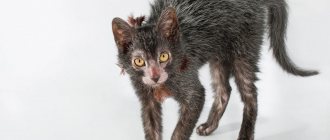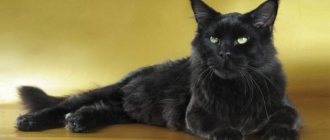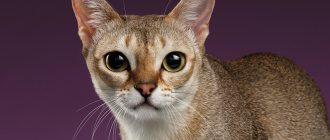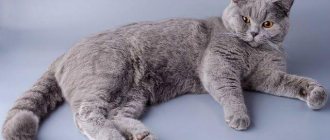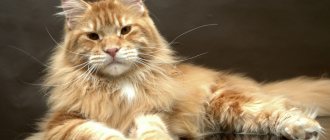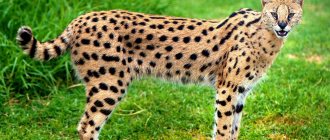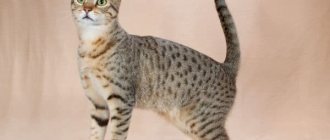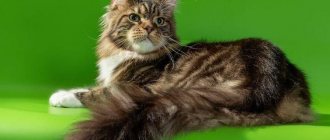Cats are much more adapted to living in an apartment than dogs. And yet, we can highlight several character traits of the animal that will make the cat simply an ideal pet for keeping in an apartment. For example, an ideal apartment cat should be calm, in some cases it may even be passive and be able to occupy itself in the absence of its owners.
You need to remember that, unlike dogs, cats prefer vertical space, so your pet will feel very comfortable if you equip it with a certain number of shelves, stands and niches. And the higher they are, the more comfortable your furry pet will be.
The list below describes the cat breeds that are best suited for apartment living.
Bengal breed
Photo Credit: lisheeny Flickr via Compfight
A relatively young breed of shorthaired cats. Representatives of this breed are distinguished by leopard print colors, like their larger wild counterparts. But in character this breed does not differ in the ferocity of its wild relative: the cat is very gentle and playful. A sort of miniature affectionate leopard in your home. But you need to take into account that Bengals are very active and very sociable. They get along well with other animals, as long as they do not consider them food or hunting.
Lifespan: 18-20 years.
Weight and size: height - 40 cm, length - 90 cm, average weight of a cat - 4-7 kg, cat - 3-6 kg.
Maintenance: minimal. Periodic bathing and brushing during shedding is all that is needed. You might be surprised, but this breed simply loves to swim. Therefore, the owners of this cat will certainly not have any problems with this. But it is necessary to accustom a cat to a scratching post from a very early age.
Devon Rex
Devon Rex cats are nicknamed "poodle cats" due to their wavy coat, high intelligence, and outgoing nature. This unique breed originated in the 1950s in Devon, England. They are distinguished by mischievous faces, high ears, huge eyes and a slender physique. The Devon Rex loves to play and climb, so it is perfect for active owners who can devote a lot of time and attention to their pet. These super social cats love people and love making new friends. They crave attention and do not tolerate loneliness well.
The Devon Rex has an elfin, almost alien appearance. This is a medium-sized cat, weighing 2.7-4.1 kg and standing about 25.4-30.5 cm in height. These curly cuties have fine, thick and wavy fur. Their fur is short, but it is especially short and less dense around the head, ears, neck, paws, chest and belly. This breed is not hypoallergenic.
Cuddling and fooling around with their owners is the Devon Rex's favorite pastime. He is not aggressive and prefers to walk away rather than deal with rude people. These cats remain playful into old age, maintaining the energy of a kitten well into old age. Although the Devon Rex can be a little demanding, it is not a particularly noisy cat breed.
They are highly intelligent, easy to train, play maze games and can learn complex tricks. However, these stubborn cats are difficult to motivate. Praise, games, and snacks are good tools.
Caring for a Devon Rex is quite simple. But it is worth considering that his short coat can easily become oily, so your pet needs to be regularly bathed in warm water with a mild pet shampoo.
British shorthair breed
Photo Credit: marttiratilainen Flickr via Compfight
The breed was finally formed towards the end of the 18th century. The breed is distinguished by its calmness and friendliness, making it perfect for a novice cat owner. This breed is easily recognized by its characteristic rounded muzzle, and their fur feels plush to the touch. If you cannot devote a lot of time to your pet, then this breed will be the ideal choice for you. Thanks to their independence, the British do not require much attention from their owner, and their peaceful nature allows them to get along well in a family where they also have children and other pets. By the way, an interesting feature of this breed is that male cats grow quite slowly; they reach their full size by about 3 years of age.
Lifespan: on average 12.5 years.
Weight and size: 30-35 cm in height, the average weight of a cat is 4-8 kg, a cat is 3-5 kg.
Care: periodic combing and wiping with a damp cloth to remove dead hair.
Abyssinian cat
Abyssinian cat
This is one of the most ancient breeds that have preserved their population to this day. Cats are graceful and have a special color. Their weight reaches up to 6 kg. Although the animal looks quite menacing, it has a soft and docile disposition. They are very curious and will not rest until they have examined every centimeter of the apartment. They love to climb various hills and will appreciate houses and scratching posts.
Advantages and disadvantages
Cats are playful, love human communication, and are not capricious.
They don't like loneliness. If it is not possible to pay regular attention, it is advisable to get another pet so that the cat has someone to play with.
The disadvantages include excessive activity. The animal loves to jump from cabinets, hang on curtains, and rush around the house at high speed.
Munchkin
Photo Credit: mila-sera Flickr via Compfight
The Munchkin is a real cat dachshund. A very funny breed with a very interesting history. In fact, all currently existing representatives of this breed descended from one cat named Ezhevichka. The owner of Ezhevichka did not breed this breed on purpose, but simply picked up a cat that was already pregnant at that time on the street. When the cat gave birth to kittens, Sandra Hochnel (the owner) noticed that half of them were short-legged. Since then, cats with short legs have become a separate breed of munchkin cats or, translated into Russian, karapuz. Although, if you are offered to buy a munchkin kitten, and the kitten’s legs are quite long, do not rush to blame the seller for wanting to deceive you, since long-legged munchkins also exist.
The short legs of munchkins do not in any way prevent them from being very active and playful animals who love communication with both children and other animals. It’s very funny to watch how munchkins, with their short legs, try to quietly steal a tasty morsel from the table. The hind legs of this breed are usually longer than the front legs, which causes the body to rise from the front to the back, making the cat look even more funny.
Lifespan: 12-15 years.
Weight and size: height -18-20 cm, average weight of a cat - 3-4 kg, cats - 2-3 kg.
Care: all care for munchkins consists of periodic brushing, which these cats perceive quite favorably. Short-haired munchkins need to be brushed once every few weeks, while long-haired munchkins need to be brushed twice a week.
Origin of dwarf breeds - where did they come from?
In nature there are many wild cat species with miniature dimensions. But domestic breeds, bred through selective breeding, are breaking all records. Breeders focus on the originality of the appearance of cats and interesting features . There is no longer any need to create large and strong breeds adapted for catching mice. Now breeders prefer compact pets.
Over the past three decades, cats have been in demand that look cute and funny as adults, and at the same time behave like kittens into old age. American and European breeders, following the fashion for pets, create miniature cats with a charming appearance, lively and playful character.
Small breeds are still not very common, but the demand for them is growing every year . In some cases, selection work requires adjustment. American specialists have achieved the best results in the selection of small cat breeds. All existing dwarf cats are the result of either gene mutation or complex hybridization. The only small breed that has not undergone significant genetic transformations is the Singaporean.
Maine Coon
American cat breed, originally from Maine. You can always recognize cats of this breed by the presence of tufts on their ears. They also usually have a furry collar, like a lion. If you have aquarium fish or hamsters in your house, then the Maine Coon will be a good choice for your family, since cats of this breed do not tend to encroach on the lives of other pets of their owners. However, this cat will not give a chance to mice that suddenly look at the light. Maine Coons have a fairly high intelligence, which makes them easy to train. Males are generally more social than cats.
Maine Coons, like British Shorthair cats, develop rather slowly. They reach adult size only by 3-5 years.
Lifespan: 12-17 years.
Weight and size: height - from 25 to 41 cm, length - up to 120 cm, average weight of a cat - 10-12 kg, cat - 7-8 kg.
Care: due to the high cleanliness of this breed, you will only need to bathe your pet when necessary, but you will need to brush it twice a week. Also, because of the cat's cleanliness, you will have to ensure that your pet's litter box is always clean.
Persians
These walking ottomans love a measured and leisurely lifestyle. They become very attached to their owners, while strangers do not arouse any interest in them.
They are well suited for those who are not used to an active lifestyle.
They love to explore new things and can be quite active if played with.
Of course, you cannot choose a pet based only on general descriptions. Each animal has its own character, sometimes unusual for the breed. So try to find a middle ground between your mind and your heart when choosing.
Manx
Photo Credit: gfacegrace Flickr via Compfight
Another feline native to Maine, but this time from the Isle of Man. This is where the name of the breed comes from. A distinctive feature of this breed is the absence of a tail, or a very short tail, as well as medium-length hair. Manx get along well with people, as they can subtly sense a person’s mood. With all this, Manx are excellent hunters and guards. Like a real watchdog, the Manx can begin to growl threateningly if he suddenly decides that something is a danger to him or your family. If suddenly the need arises to change the family for a cat, the Manx easily adapts to new people and a new environment.
Manxes are very obedient cats, and if you tell him not to scratch the sofa with his claws, he won't do it. However, in this case, it is better for you to offer him a scratching post instead of the sofa as an alternative.
Lifespan: 8-14 years.
Weight and size: height - 18-23 cm, weight - 3-6 kg
Care: brushing once or twice a week, more often during shedding.
Persian breed
Photo Credit: jayohaycheen Flickr via Compfight
Probably the most beloved breed in the world. The most popular are Persians with long hair and a short nose, although there are also representatives of the breed with long noses. According to breed standards, Persians' eyes are quite bright and rich in color.
Persians are sedate and important cats who do not like fuss and loud sounds. Cats are conservative, preferring stability and predictability to changes and innovations. This is probably the only breed that does not try to climb somewhere higher, being content with more accessible surfaces. Since Persians are very fluffy cats, you need to be prepared for the fact that there will be a lot of hair on furniture and clothes.
Lifespan: 12-17 years.
Weight and size: height - 20-25 cm, weight of a cat - 4-5 kg, cat - 3-4 kg.
Care: Persians need to be brushed daily and they must be accustomed to this procedure from childhood, so that in the future they will be more relaxed about this procedure. Persian owners should pay special attention to their eyes and breathing. The eyes must be wiped periodically to prevent the accumulation of bacteria that cause conjunctivitis. And breathing problems can arise due to the structural features of the nose of this breed.
Singapura cat
Singapore cat
Representatives of this breed are extremely miniature. Their weight does not exceed 3 kg. But despite this, cats deftly jump, climb and hunt.
Advantages and disadvantages
Character is affectionate and sociable.
The cat will always be close to people. She will watch the cooking and run around the house with the baby.
Treats strangers well and is always happy to have guests.
He easily learns simple commands and walks calmly on a harness.
The Singapura cat is not afraid of water and is happy to splash around with her favorite toy in the bath.
To avoid damage to property, especially in the first years of life, it is necessary to constantly entertain the animal.
Russian Blue breed
Photo Credit: selchuk_hoo Flickr via Compfight
The favorite of the Russian royal house, the Russian Blue cat is distinguished by its grace, elegance and intelligence. She has a long neck, thin, slender legs, a narrow muzzle with emerald green eyes and a delightful gray-blue coat. Photographers often photograph models paired with this cat.
The character of the cat is also delightful. Are you afraid that if you take a cat home, you will face the problem of marking the territory? Then Russian Blue is what you need. Males of this breed do not engage in such disgrace. In the spring, this breed will not cause trouble to its owners with demanding cries that they need a mate. Cats are not intrusive, not aggressive, very clean and get along well with children and other pets. They show affection only to members of their own family; they behave very shyly with strangers. Knows how to entertain himself in the absence of his owners. When seeing an upset owner, she tends to show sympathy.
Lifespan: 10-20 years.
Weight and size: height - 20-25 cm, length - about 60 cm, weight - from 3 to 7 kg.
Care: all cat care consists of periodic brushing and regular cleaning of the litter box. If you don’t clean the tray on time, you risk running into a protest in the form of eliminating natural needs in an inappropriate place. It should also be remembered that this breed may have a tendency to overeat and gain excess weight, so it is better to give up the idea of treating your pet with a tasty treat once again.
Boy or girl?
When a family decides to adopt a kitten, among other things, the question arises: is a boy better or a girl?
Advantages of cats (females):
- they are cleaner because they take better care of themselves;
- do not seek to dominate;
- more flexible and affectionate.
But with the advent of puberty, the owner has a question: what to do with the offspring? There may be problems with this if the animal was not taken for breeding. Pregnancy is preceded by estrus. The cat leaves marks with a specific musky odor, and for a week or more makes loud noises, especially at night, calling for a male. This ends on its own or after mating with a cat.
Cats like to flirt with their owners
Cats are leaders by nature. They control every step of the inhabitants of the house. Most cats are not affectionate, although sometimes they allow themselves to be picked up and stroked. They become aggressive if a person does something they don't like.
One of the problems that cat owners face is marking their territory. Often, breeders manage to wean their pupils from such behavior. Males smell stronger. But the smell disappears if the animal is properly cared for.
Many problems can be solved by sterilization and castration. But even a castrated male can leave marks. This happens in the following cases:
- late castration;
- the presence of another cat;
- stress, anxiety;
- uneasy situation in the house;
- lack of attention from the owners;
- dirty tray;
- discontent;
- health problems, bladder infections.
Cats show aggression if they don't like something.
Ragdoll
Translated from English, the name of this breed means “rag doll” and this perfectly characterizes these cats. The peculiarity of this breed is that they have reduced muscle tone, and because of this they relax to an incredible degree. You may get the impression that what is lying on your lap is not a cat, but its skin. Representatives of this breed also have blue eyes.
Ragdolls are very trusting and good-natured cats, often unable to protect themselves, so it is better not to let this cat walk alone for its safety. Despite their obedience and amazing ability to completely relax and lie where the owner puts him, cats of this breed cannot be called inactive. They love to play and perform various tricks, which they learn quite quickly. Just like Persians, Ragdolls are not too fond of the highest surfaces in the house, preferring to stay close to people. They are very affectionate, and not only to people. They can even make friends with a pet that they would rather consider as food than as a friend.
Lifespan: 12-15 years.
Weight and size: cat height - up to 40-66 cm, cat height - up to 38-58 cm, cat weight - 7-11 kg, cat weight - 6-10 kg.
Grooming: Despite their relatively long hair, Ragdolls do not shed as intensely as one might expect. But, nevertheless, daily brushing is highly desirable for this breed. You can bathe your Ragdoll once a month.
Skookum: 1.8 – 4 kg
Skookum
Representatives of the Skookum breed, which is a derivative of the Munchkins, can have approximately the same weight indicators. When crossing munchkins and laperms, cats appeared that were equally short in stature and short legs, and received long hair that grew in lush waves. The calm, affectionate creature wins hearts, which makes the breed more and more popular.
Interesting: How do cats predict earthquakes?
Sphinx
Photo Credit: my destination's beautiful Flickr via Compfight
Despite the fact that the Sphynx breed is quite ancient, modern Sphynxes appeared only in the 20th century. Initially, the breed was not specially bred, and appeared as a result of a natural mutation, but then breeders began to make attempts to repeat the birth of hairless kittens. Since then, the Sphynx breed has become increasingly popular. One thing is obvious: there is no such person who would remain indifferent to him. Anyone who sees the Sphinx begins to feel either incredible sympathy or complete rejection.
Sphynx cats are very active, inquisitive, intelligent and get along well with other pets. The Sphinx's favorite place to stay is the lap of its owner. But he will not impose himself on you if you are not in the mood to communicate with him.
Lifespan: 10 -15 years.
Weight and size: height - 20-25 cm, cat weight - 4-5 kg, cat weight - 3-4 kg.
Care: In terms of care, the Sphynx will require more attention from you than any other breed. It is necessary to bathe your Sphynx every week, otherwise he will start to smell unpleasant and leave greasy marks on the furniture and your clothes. Between baths, you can wipe your Sphynx with wet wipes. In the summer, the Sphynx needs to be protected from sunburn, and in the winter, you will have to wrap it in cat sweaters and overalls. The eyes and ears of sphinxes will also require special attention. They must be wiped once a week with damp cotton pads.
Which cat is best for a child?
Each cat breed has its own characteristics, which it is better to know about in advance, and its own character. If there is a child in the family, it is of course better to choose a cat among non-aggressive, friendly, playful breeds. Before purchasing, familiarize yourself with the characteristics of the breed and prepare for possible difficulties.
If you have decided on a breed, pay close attention to the breeders. Unfortunately, there are now more and more people who are trying to make money from breeding without caring about the health of the animals. A low cost may indicate that the animal was raised in poor conditions and fed cheap food, without veterinary control, or the kittens were the result of inbreeding. Such cats can have a number of serious defects and diseases.
It is important for parents to remember: no matter what animal they get, they must carefully monitor the health of their pet. Firstly, we are responsible for those we have tamed, and secondly, our smaller brothers themselves can become carriers of some diseases dangerous to humans if basic prevention rules are not followed.
Be sure to visit a veterinarian for a preventive examination and vaccination at least 1-2 times a year. At least 2 times a year, you should drive away worms with special means: even if the cat sits in the apartment forever, you yourself can bring helminth eggs or dangerous viruses from the street on your shoes. When going outdoors, don’t forget to treat your fur against fleas and ticks.
Scottish Fold breed
A young breed dating back to the 20th century. A distinctive feature of the breed is the hanging ears, which give the round muzzle of the Scottish Fold even greater roundness. Interestingly, kittens of this breed are initially born with straight ears, which then begin to fold. They reach their final appearance at about 12 weeks. The Scottish Fold is a very hardy breed and adapts well to any conditions. Usually, they choose only one of the family members as their owner, but they also behave very friendly with other family members, be it a person or another pet.
Representatives of the breed are moderately active, intelligent and love games in which they can use their intellectual abilities. But most of all he enjoys communicating with people. He tries to take part in all matters that the family is involved in.
Lifespan: 11-14 years.
Weight and size: height - 20-25 cm, cat weight - 3-5 kg, cat weight - 2.5-3.5 kg.
Grooming: Grooming depends on the length of the coat. Long-haired representatives of the breed should be brushed more often to avoid the appearance of tangles. Particular attention should be paid to ear cleaning, which should be taught from early childhood. You should also have your pet's ears checked periodically by a veterinarian for parasites and infections. To prevent excess weight gain, you need to follow a diet and not overfeed your pet. You should handle the Scots tail with caution: do not pull it under any circumstances. If you notice that your cat is in pain when moving its tail, it is best to ask your veterinarian to check whether your cat has arthritis. Unfortunately, joint diseases in this breed are genetic.
The ten best cat breeds for apartment living
The main criteria for choosing a feline companion in such a situation are:
Of course, upbringing and training play a big role, but initial character traits also play a significant role. Therefore, we have selected ten breeds whose maintenance in the city is most optimal.
Ragdoll
This cat breed fully lives up to its name. After all, “Ragdoll” translates as “rag doll.” The main distinguishing features of these cats is their ability to relax in human hands. These are quite large cats with a characteristic color-point color (mitted and bicolor are less common) and have a very calm character. Males of this breed reach a length of 1 meter, weighing 8-10 kg. Kitties are slightly smaller, their maximum weight is limited to 5-6 kg, and their body length rarely exceeds 80 cm.
The touching blue eyes of these aristocrats captivate at first sight. At the same time, ragdolls are very attached to their owners and are absolutely unpretentious. They get along easily with small children and other animals. It's no surprise that they are among the top five most popular cat breeds worldwide.
Burmese breed
The Burmese cat has a dense build and short legs. Sizes range from medium to large. Wide head with a prominent forehead, medium-sized ears. At the moment, more than 20 color options have been bred, but their eyes are always blue or bright blue.
Since this breed was bred specifically as a companion pet, the character of representatives of this breed is very sociable and curious. They are able to get along with almost all representatives of the animal world, with the exception of very active or aggressive ones. They quickly become attached to children and are always happy to play active games. The Burmese are flexible, not prone to conflict, intelligent and friendly.
They do not tolerate prolonged loneliness very well and miss their owners a lot. Therefore, it is not advisable to leave them unattended for a long period of time.
Maine Coon
These cats are considered one of the largest domestic cats. Males weigh on average 6-9 kg. Their length can reach 120 cm, of which 36 cm is the bushy tail. Females are slightly smaller - their weight rarely exceeds 5.5 kg. Neutered individuals can weigh 2-3 kg more than their sexually mature peers.
Maine Coons are well adapted to life in adverse conditions. Their origin has quite a lot of “blind spots”, but it is believed that the breed standard was formed naturally. But at the same time, they feel great even in a small apartment. True, their fur requires regular care - combing and, if necessary, washing. However, this applies to all long-haired breeds, especially during the changing seasons.
Despite their outward severity, Maine Coons are an ideal option for a family with small children, to whom they quickly become attached. They have an easygoing disposition, kind character and easy-going attitude. Although they love the company of their owners, they can also tolerate loneliness quite calmly.
British Shorthair
One of the most famous cat breeds. It enjoys well-deserved popularity for its many advantages. The British have a short coat, but it is soft and fluffy. The number of colors recognized as meeting breed standards has already exceeded 30 (blue-gray, black, chocolate, tabby, lilac, etc.). The characteristic color of the iris is deep orange.
Unlike most of their brothers, representatives of this breed are self-sufficient and can easily tolerate prolonged loneliness. They hardly need human attention. Phlegmatic, easy to get along with others. They are distinguished by their peacefulness and restraint, although they are very proud, they have their own views on many things. Therefore, you need to educate them “for yourself” from a young age.
Russian blue
Unlike other breeds from this collection, the Russian Blue is independent. At the same time, they are very smart, tactful and obedient. A combination of a gentle character and a certain tact. Therefore, this is not a cat that will allow itself to be cuddled. Although it can sit next to its owner for a long time. Very sensitive to human speech and gestures.
The Russian Blue cat is wary of strangers until it studies him and recognizes him as “one of his own.” But she quickly becomes attached to children and enjoys participating in various active games. They do not tolerate loneliness very well, but they love to travel and easily adapt to any innovations in their life.
It is very popular in the world for its rat-catching abilities, non-standard coloring and special “plush” coat structure. At the same time, she is quite unpretentious in care, even during the molting period she can be combed out every other day.
Siamese cats
Everyone recognizes these cats because of their original appearance. Slender flexible body, expressive turquoise almond-shaped eyes, large ears and a thin long tail. And although Siamese have a rather complex, independent and vindictive character, they are ideal for keeping in a city apartment.
Cats of this breed are very attached to their owner; they can be jealous of other people and pets who live with him. Loneliness is not for Siamese cats; they definitely need communication. This is another characteristic of this breed, they are prone to verbal communication and have a very loud voice.
Many people choose the Siamese breed for its beautiful appearance, miniature size (maximum weight 6 kg) and excellent health. In most cases, grooming for Siamese is minimal.
American Shorthair
This breed is considered the most versatile. Its representatives are quite unpretentious and do not require special care. Short hair only needs special attention during shedding periods. The athletic build meets the original purpose of breeding – hunting mice.
Moreover, in the modern world this cat has gained popularity because of its love of love and affection for its owner. But at the same time, she calmly endures long-term loneliness, without intruding or demanding attention. The American is not aggressive towards children and other pets (except for “prey” - small rodents and birds), but does not like unnecessary intrusion into her personal space.
Abyssinian cat
This breed is considered one of the most ancient; its standard was approved back in 1882. It has several officially recognized color options: wild (orange-brown), sorrel, blue, fawn (light red). In addition, several other colors are recognized by different associations, including lilac, cream, chocolate and tortoiseshell.
The muscular body and flexible movements give representatives of this breed a resemblance to a miniature wild puma. After all, the weight of an adult Abyssinian rarely exceeds 4.5 kg. Her slanting, almond-shaped eyes of amber or green hue add a special charm to her appearance.
For all their predatory appearance, these cats are very intelligent and patient. They are extremely rarely able to extend their claws, only to protect themselves from obvious aggression. They love active games and love to play with children. But at the same time, they do not tolerate familiarity and rude treatment, so it is better not to leave small children alone with them.
Burmese Shorthair (Burmese)
Cats of this breed have a muscular body with short, shiny hair. The eyes of the Burmese are bright yellow, round in shape, which can change shade depending on the degree and type of lighting. Despite their external miniature size, their weight can reach 6 kg. Therefore, they are sometimes called “bricks in velvet skin.”
They are distinguished by their love of active games and retain an easy-going character for a long time. A sort of “eternal kittens” that easily get along with both children and elderly people.
They need a lot of attention and do not like to be left alone. Thanks to their affectionate, playful nature, they get along well with other pets, including dogs.
Persian cat
One of the most famous and popular breeds in the whole world. Unlike representatives of many other breeds, Persians are not able to survive outside the home.
The character of these cats is generally complex; they are stubborn and willful, but they do not show these qualities often. The tranquility and immutability of the world around them is important to them. Then their balanced disposition delights those around them. Persian cats are almost incapable of aggression; if an unpleasant situation arises, they will prefer to retreat away from their source. Although under certain circumstances they may take revenge.
They are attached to their owner and can sit next to him for hours, waiting for affection and attention. But they rarely vote. Although Persians are considered lazy, capable of lying on soft bedding all day long, they love outdoor games. Even adult cats enjoy chasing a ball or catching a “butterfly” on a string.
Of course, this is not a complete list of purebred cats accustomed to living in an apartment. When choosing a pet companion, you should also pay attention to its parents, where it was raised, and its current state of health.
Source
Exotic shorthair breed
Photo Credit: zilvinas.za Flickr via Compfight
A cat breed that was accidentally created by crossing the American Shorthair and Persian breeds. The breeders were just trying to achieve a new shade of fur and a more massive body, but in the end they got a new breed. Cats of this breed have the same flat face as Persians, but the hair is usually short. Although kittens with long hair are also born from exotic shorthairs and are even recognized by experts.
This breed is easy to train and probably understands the word “no” better than all other cat breeds. And of course, you will be pleased by the fact that exotics do not damage furniture and clothes even as kittens. They rarely use their claws at all.
Cats of this breed do not impose their company on people, but will play with pleasure if they are invited to participate. They sleep most of the day, and are usually active in the morning and evening. Therefore, he can easily endure loneliness while you are at work. This is one of the most affectionate and loyal cat breeds.
Lifespan: 12-13 years.
Weight and size: height - 25-30 cm, cat weight - 3-6 kg, cat weight - 2.5-4.5 kg.
Care: combing the fur during the molting period will get rid of hair on furniture and clothes. Exotics need to wipe their eyes with a damp cotton swab several times a week. It is enough to bathe your pet once a month.
How to choose a cat breed
When choosing a kitten for your home, it is advisable to proceed from the characteristics and interests of the family, the presence of other pets, small children, and allergy sufferers. For a village or country house, ratcatcher cats are required. In an animal for an apartment, first of all, communication skills, the ability to get along with people, and a calm disposition are important.
Criterias of choice
Basic criteria for choosing a cat breed:
- owner's lifestyle;
- difficulty of care and maintenance;
- character;
- unusualness.
The owner's lifestyle. Busy working people, single pensioners, families with children should choose different purebred pets based on their usual lifestyle and time for a tailed pet.
- Independent cats that tolerate loneliness well in the absence of the owner - British Shorthair, Scottish Fold, Maine Coon. They do not require unnecessary attention, do not bother you if you are not in the mood, they will find something to do for themselves or will sleep peacefully on their favorite bed.
- If you want to buy a pet for a child, then it is appropriate to focus on kind, patient breeds that are able to leniently tolerate children's pranks and engage in joint games. Most often, playful lovers of pranks with an easy-going character are chosen for children: Norwegian Forest, Siamese, Bengal.
- A lonely person lacks communication; such people choose cats that are affectionate, loyal, affectionate and sociable. It will be nice to while away long evenings with them, talk about everything, sit in an embrace on a soft sofa. Affectionate, talkative breeds: Thai, Bengal, Cornish Rex.
- For a private home, it is better to choose a cat with a good hunting instinct to fight rodents. American Shorthair, Siberian, and Scottish Fold will be excellent at exterminating mice and rats.
- If the family already has pets, cats or dogs, then an American Bobtail, Thai, or Himalayan are ideal partners. They are friends with dogs, willingly play with other cats, sleep together, lick each other.
Difficulty in care and maintenance. Depending on its characteristics, each cat breed requires more or less attention and time for care, and is simple or difficult to maintain.
- The easiest to care for are unpretentious in food, without thinking through the daily menu, and short-haired pets that do not require combing or daily cleaning of the apartment when shedding.
- If you have the time and desire to carefully care for your tailed pet, then long-haired breeds, which often shed and require constant care for their fur, are ideal, as well as hairless breeds, whose representatives need to create a special temperature regime, constantly freeze or sweat, and therefore have to wash frequently.
- Difficult in keeping can also include the Persian with a specific flat muzzle, due to the structure of which diseases are often possible, the Scottish Fold with special care for unusually shaped ears, all varieties of Sphynx - hairless cats, which must be carefully warmed, without allowing thermal blows from overheating.
Character. Each breed of cat leaves its mark on the character of the animal, its temperament and disposition.
- There are talkative and sociable dogs that are suitable for those who are used to having philosophical conversations and cannot tolerate oppressive silence in the house: Canadian Sphynx, Siamese, Thai.
- The list of silent felines for which meowing is the exception rather than the rule includes the Cornish Rex, Siberian, and American Shorthair. They are turned on by people who value tranquility and who are irritated by unnecessary sounds.
- Active, active tailed cats, constantly in motion and exploring space, the owner will have to constantly come up with new activities, although they often find them themselves by examining the contents of cabinet drawers, shelves and racks. Prominent representatives of restless cats: Bengal, Abyssinian.
- The list of the laziest is headed by the British, Persian, and Siberian. It is important for them to eat heartily and sleep to their heart’s content. Sometimes owners may even forget about their presence in the house, the cats spend so much time in the kingdom of Morpheus.
- Loving people will be delighted with the most affectionate cats that constantly follow their owner in anticipation of hugs and other tenderness: Sphynx, Ragdoll, Burmese. You should only get them if you are ready to give your pet a lot of attention and affection.
- Intelligent breeds that are easy to train, understand human speech, and can learn simple commands. Smart cats - Siamese, Oriental, American Bobtail.
Unusuality. If the main thing for you in a cat is its unusual appearance, and you are willing to overpay for this, since the average price is quite high, then it is advisable to study the list of the most exotic breeds that are available in nurseries:
- American Curl - funny curled ears catch the eye;
- Devon Rex - has an alien appearance and huge ears;
- Cornish Rex - short curly fur, wedge-shaped head, thin limbs are touching;
- munchkin - characterized by a cute face of a plush toy, thick short legs;
- Laperm - unusually soft fur with large curls.
What should a breeder provide when selling a purebred kitten?
To avoid mistakes when choosing a purebred pet, be sure to require the seller to provide the following important points:
- Complete reliable information about the pet. If the seller hides information, refuses to answer, or does not know the answers to the questions asked, then this means that this is an incompetent breeder or reseller who may turn out to be a scammer.
- Full examination of the animal. You should pay attention to the condition of the kitten’s claws, teeth, ears, fur, eyes, degree of mobility and fatness. If the animal is too lethargic, timid, does not respond to external stimuli, or has problems with the above body parts, this may be a signal of a painful condition and the possible death of the animal subsequently. You should choose an inquisitive, confident, playful kitten with excellent physical characteristics.
- Documents - veterinary passport and birth certificate (pedigree). It is appropriate to contact the club with which the parents and litter are registered to ensure the authenticity of the documents. They should indicate the timing of vaccination, quarantine of the kitten, information about the animal’s mobility, temperament, exterior defects, maintenance rules, disease prevention, kitten skills, and features of preparation for exhibitions.
Some felinological clubs issue a certificate stating that the baby has no hereditary genetic diseases that may be characteristic of the breed.
Recommendations when choosing
If you want to buy a healthy purebred pet, it is advisable to follow a few tips from experienced cat lovers:
- When choosing a suitable breed, you need to study living stories and reviews on cat lovers forums, and not focus solely on breeders’ websites. The more information you collect about the breed, the more confident you will be in making the right choice.
- Carefully read the information provided by the seller and the kitten’s documents. Ask any questions you have, contact the club with a request about the parents and litter. If you have doubts about the purity of the breed, it is better to refuse the purchase.
- The metric should contain a description of important information: pedigree number, date of birth, parental information, breeder coordinates, breed, gender, nickname. The pet's veterinary passport must contain information about vaccinations against viral infectious diseases, rabies, dermatomycosis, preventive measures and examinations.
- When choosing a kitten, it is not enough to look only at a photo; it is appropriate to see it in person, and ideally, to also see the parents. The best option where to buy a purebred animal is at an exhibition where kittens are shown in detail.
- You should take into account the fact that purebred kittens cannot be cheap in price. How much an animal costs depends on the class: pet (for home keeping), breed (for breeding), show (for exhibition activities). The most inexpensive pets for the home at a budget price are offered from a selection of higher classes, with minor defects in the exterior.
